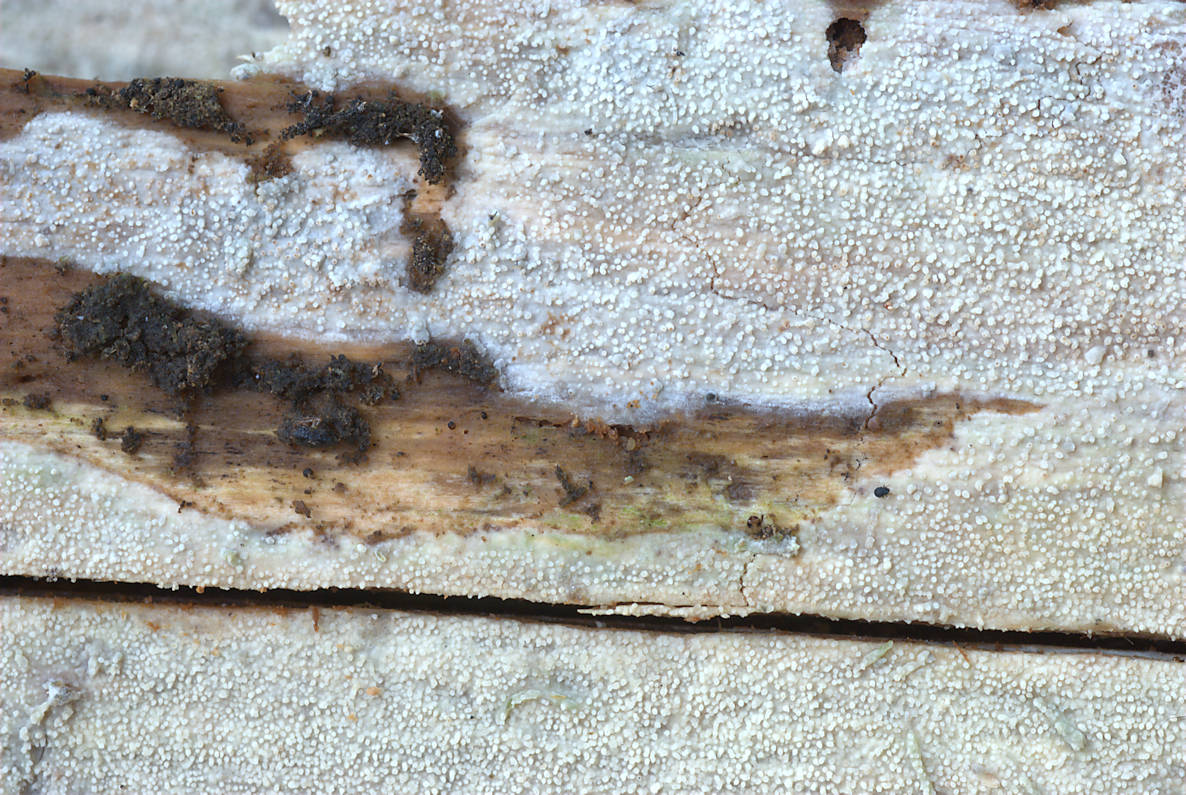
This genome was sequenced as part of the JGI CSP "1000
Fungal Genomes – Deep Sequencing of Ecologically-relevant
Dikarya" project. Within the framework of this project, we are
sequencing keystone lineages of saprophytic, mycorrhizal, and
endophytic fungi that are of special ecological importance. Dozens
of sequenced species were harvested from Long Term Observatories to
serve as the foundation for a reference database for metagenomics
of fungi and for a comprehensive survey of the soil fungal
metatranscriptome.
Resinicium bicolor
Resinicium bicolor is a common corticioid white-rot
fungus in boreal and temperate areas throughout the Northern
Hemisphere. It prefers to grow on coniferous wood but can also
frequently be found on deciduous trees. It is among the most
dominant wood-decomposers of spruce in North Europe and Canada
(Nakasone 1990), but easily overlooked due to its inconspicuous,
thin effused fruiting bodies, which are translucent when young. The
fruiting bodies bear small spines on the surface, and large calcium
oxalate crystals (asterocystidia) and capitate cystidia
(halocystidia) make this species easy to identify under
microscope.
Resinicium bicolor belongs to the Hymenochaetales
(Agaricomycetes, Basidiomycota), and is the type species of the
genus Resinicium. Phylogenetic analyses indicate that it
may be among the earliest diverging members of the order (Larsson
et al. 2007). It has reportedly a bipolar mating system, which is
relatively rare among wood-inhabiting basidiomycetes (Nakasone
1990). Resinicium bicolor has been subject to a number of
studies focusing on its physiology (Connolly & Jellison 1995),
population structure (Kirby et al. 1990), (experimental) community
ecology (Holmer & Stenlid 1993, 1996, 1997, Zakaria & Boddy
2002, Hynes et al. 2007, Lindner et al. 2011, Hiscox et al. 2018),
pre-treatment of wood in pulp production (Job 2002), and in
detoxification of waste rubber material (Brederg et al.
2002).
The strain used for genome sequencing originates in Helsinki,
Finland. It is a heterokaryon, and was produced from a spore print
of a fruiting body that grew on a fallen, dead spruce trunk.
The 1KFG project is a large collaborative effort aiming for master
publication(s). Please do contact the PI for 1KFG - Deep Sequencing
of Ecologically-relevant Dikarya (Dr. Francis Martin) for
permission prior to the use of any data in publications.
References:
- Bredberg K, Erik Andersson B, Landfors E, Holst O (2002) Microbial detoxification of waste rubber material by wood-rotting fungi. Bioresource Technology 83 (3):221-224. doi:10.1016/S0960-8524(01)00218-8
- Connolly JH, Jellison J (1995) Calcium translocation, calcium oxalate accumulation, and hyphal sheath morphology in the white-rot fungus Resinicium bicolor. Canadian Journal of Botany 73 (6):927-936 doi:10.1139/b95-101
- Hiscox J, O'Leary J, Boddy L (2018) Fungus wars: basidiomycete battles in wood decay. Stud Mycol 89:117-124. doi:10.1016/j.simyco.2018.02.003
- Holmer, L. and Stenlid, J. (1993) The importance of inoculum size for the competitive ability of wood decomposing fungi. FEMS Microbiol Ecol 12: 169-176. doi:10.1111/j.1574-6941.1993.tb00029.x
- Holmer, L. and Stenlid, J. (1996) Diffuse competition for heterogeneous substrate in soil among six species of wood decomposing basidiomycetes. Oecologia 106: 531-538. doi:10.1007/BF00329712
- Holmer, L. and Stenlid, J. (1997) Competitive hierarchies of wood decomposing basidiomycetes in artificial systems based on variable inoculum size. Oikos 79: 77-84. doi:10.2307/3546092
- Hynes J, Müller C, Jones TH, Boddy L (2007) Changes in Volatile Production During the Course of Fungal Mycelial Interactions Between Hypholoma fasciculare and Resinicium bicolor. J Chem Ecol 33 (1):43-57. doi:10.1007/s10886-006-9209-6
- Job D (2002) Assessment of selected decay Basidiomycetes for selective biodefibrillation of Picea abies wood. Mycol Prog 1 (2):123-129. doi:10.1007/s11557-006-0010-2
- Kirby, J.J.H., Stenlid, J., Holdenrieder, O. (1990) Population structure and responses to disturbance of the basidiomycete Resinicium bicolor. Oecologia 85: 178-184. doi:10.1007/BF00319399
- Larsson K-H, Parmasto E, Fischer M, Langer E, Nakasone KK, Redhead SA (2007 ['2006']) Hymenochaetales: a molecular phylogeny for the hymenochaetoid clade. Mycologia 98 (6):926-936. doi:10.3852/mycologia.98.6.926
- Lindner DL, Vasaitis R, Kubartová A, Allmér J, Johannesson H, Banik MT, Stenlid J (2011) Initial fungal colonizer affects mass loss and fungal community development in Picea abies logs 6yr after inoculation. Fungal Ecology 4 (6):449-460. doi:10.1016/j.funeco.2011.07.001
- Nakasone KK (1990) Cultural studies and identification of wood-inhabiting Corticiaceae and selected Hymenomycetes from North America. Mycologia Memoirs 15:1-412
- Nobles MK (1953) Studies in wood-inhabiting Hymenomycetes I. Odontia bicolor. Canadian Journal of Botany 31:745-749 doi:10.1139/b53-057
- Zakaria AJ, Boddy L (2002) Mycelial foraging by Resinicium bicolor: interactive effects of resource quantity, quality and soil composition. FEMS microbiology ecology 40 (2):135-142. doi:10.1111/j.1574-6941.2002.tb00945.x
